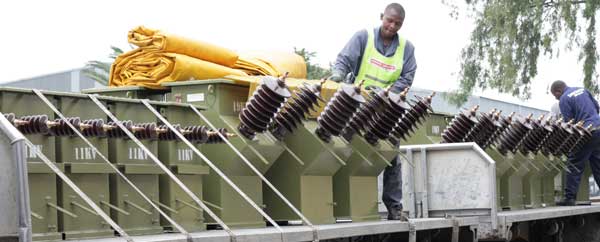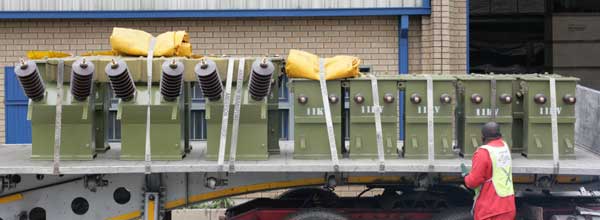Transformers are used for transmission as a step up devices so that the I2r loss can be minimized for a given power flow. They are used in Distribution Network so directly connected to the consumer so load fluctuations are very high.

Transformers distribution substations connect to the transmission system and lower the transmission voltage to medium voltage ranging between 2 kV and 35 kV with the use of transformers. Primary distribution lines carry this medium voltage power to distribution transformers located near the customer's premises. Distribution transformers again lower the voltage to the utilization voltage of household appliances and typically feed several customers through secondary distribution lines at this voltage. Commercial and residential customers are connected to the secondary distribution lines through service drops. Customers demanding a much larger amount of power may be connected directly to the primary distribution level or the sub-transmission level.
Low voltage lighting systems require less voltage to operate than the typical line voltage supplies. If your wall receptacle outputs 120 volts, that's far more than your 12 or 24 volt light fixture will need. Low voltage transformers step down the voltage to match your light fixture requirements. Without these converters, the electricity coming from your wall receptacle would be far too powerful to operate your lights and would burn them out.

A low voltage transformer transforms the standard line voltage in your home or business (120 or 277 volts) to a lower 12 or 24 volts. This ensures you safely supply power to popular low voltage lighting systems like recessed can lights, pendant lights, puck lights and outdoor light fixtures.
Medium voltage transformers mainly step utility power (1 to 35 kV primary) down to 480 V or less, three-phase current for motor-driven equipment and for further voltage reduction downstream. Medium-voltage transformer also helps to minimize voltage drop. It can also help reduce cable sizes is by reducing or eliminating ampacity adjustment factors when installing conductors underground.
Any facility where the operation demands large amounts of power, such as data centres and industrial plants, is a great candidate for using medium voltage in data centres; the distribution system includes backup generators to keep the facility operational during outages and redundancy to eliminate single points of failure. Large facilities and campus-type facilities often contain centralized chiller plants and/or a generating plant. Both of these systems can be operated at medium voltage, eliminating transformation equipment and their associated losses.
Facilities that have the potential for long feeder runs, such as large footprint warehouses, campuses, and high-rise buildings, are also good candidates for medium-voltage distribution. Medium-voltage transformers contain only the switching mechanism to open/close and do not have an integral overcurrent protection device.